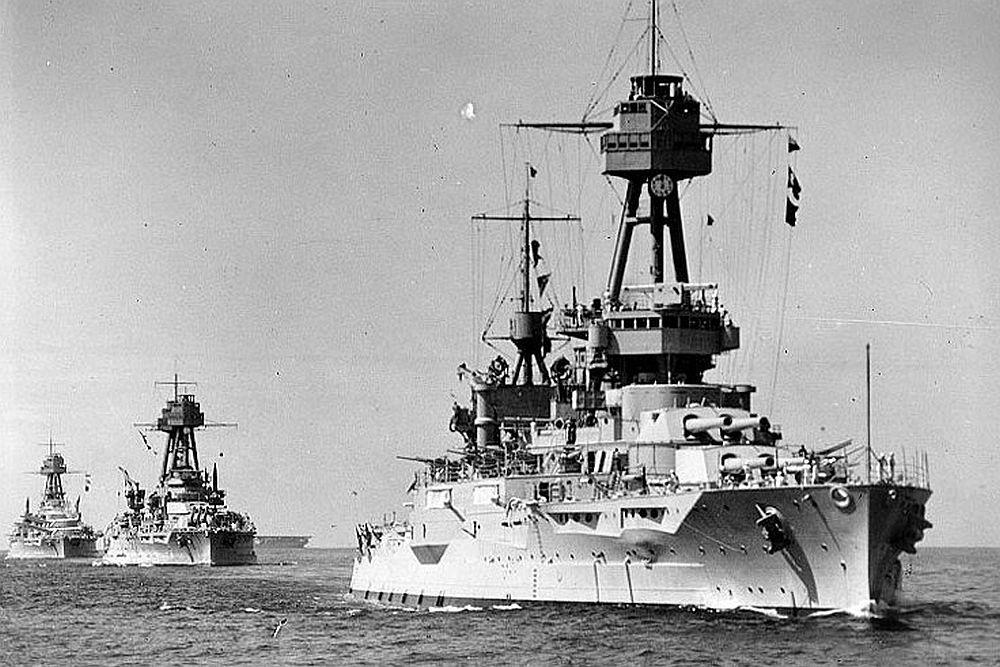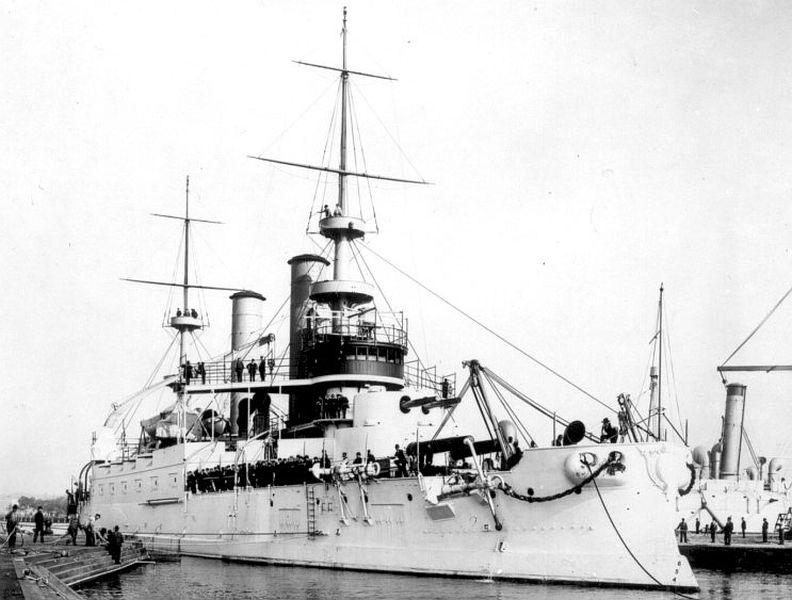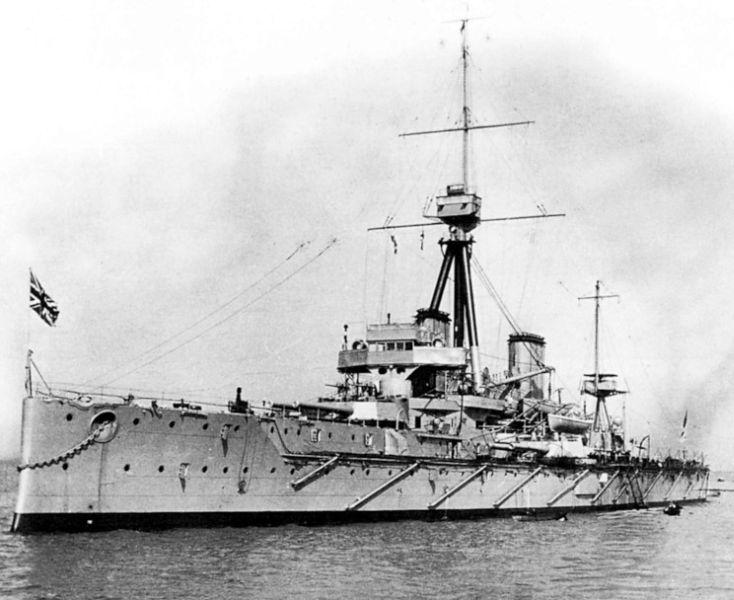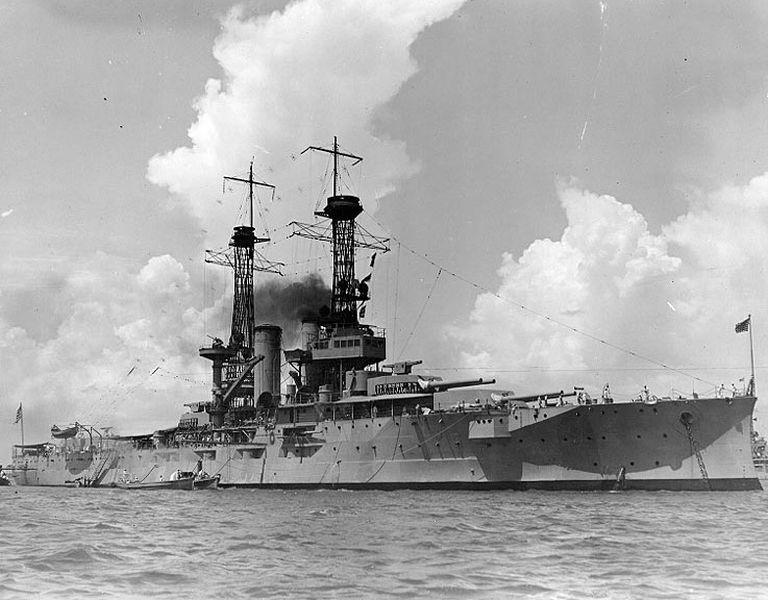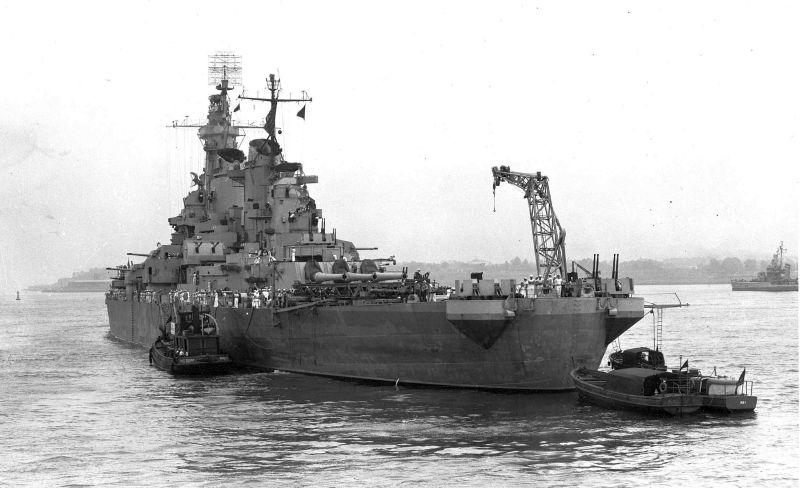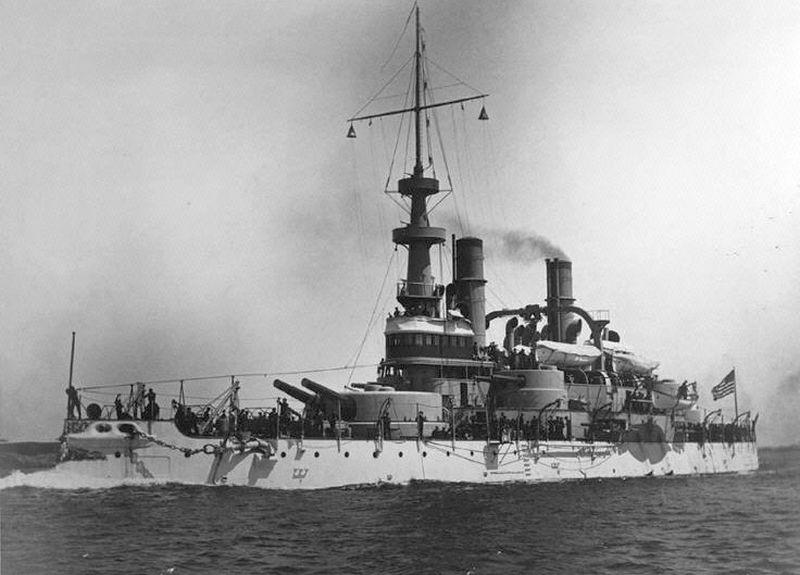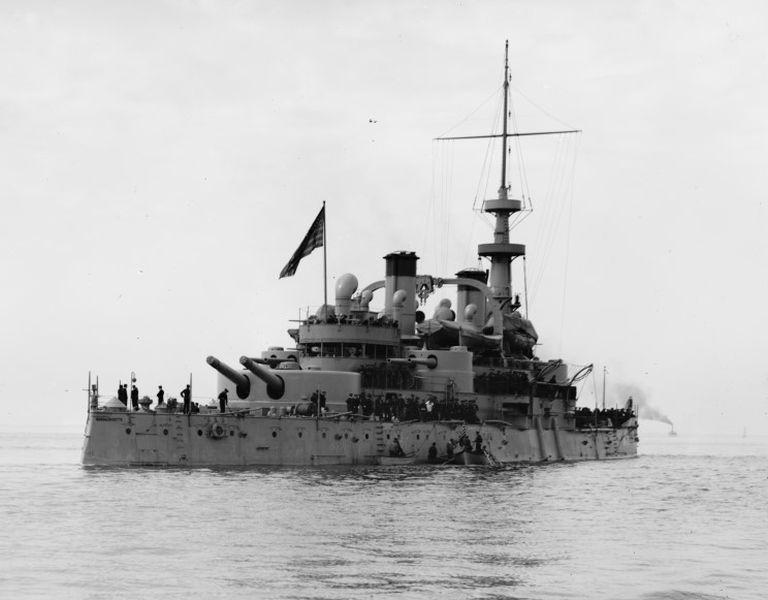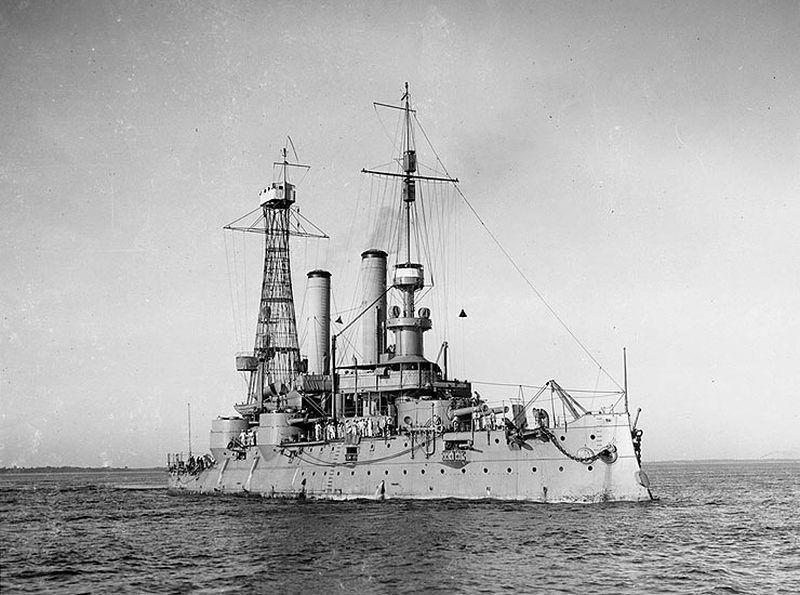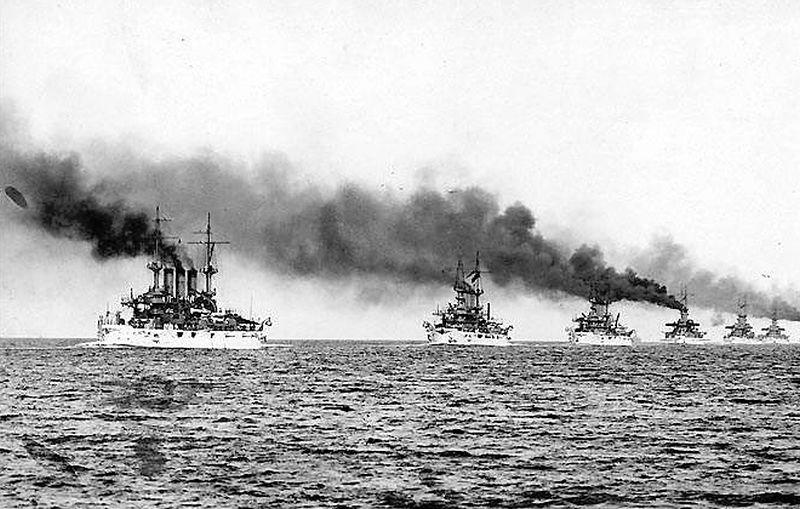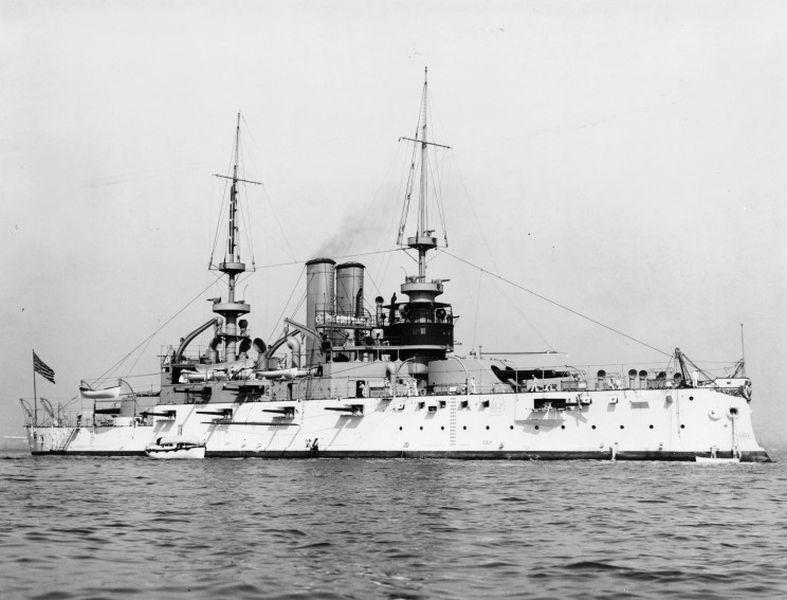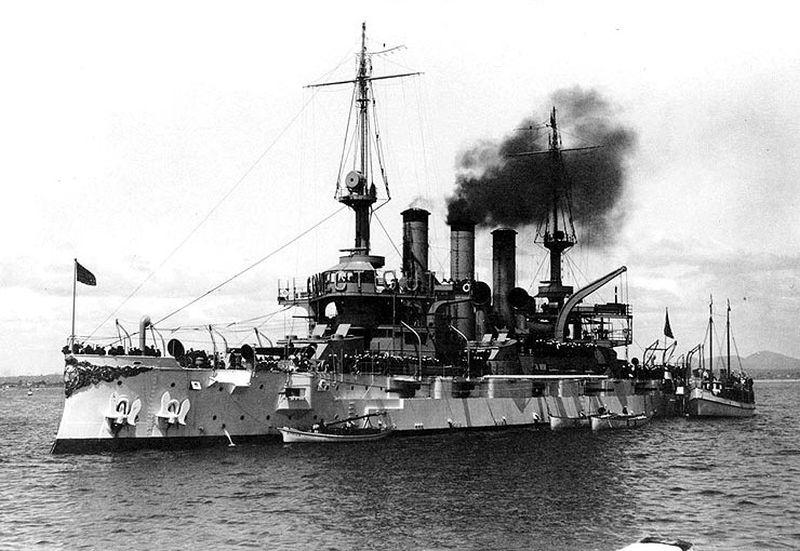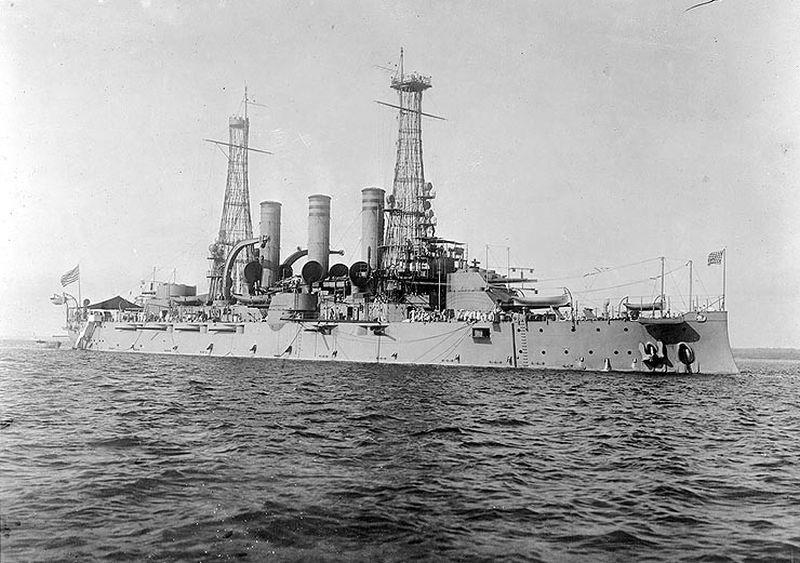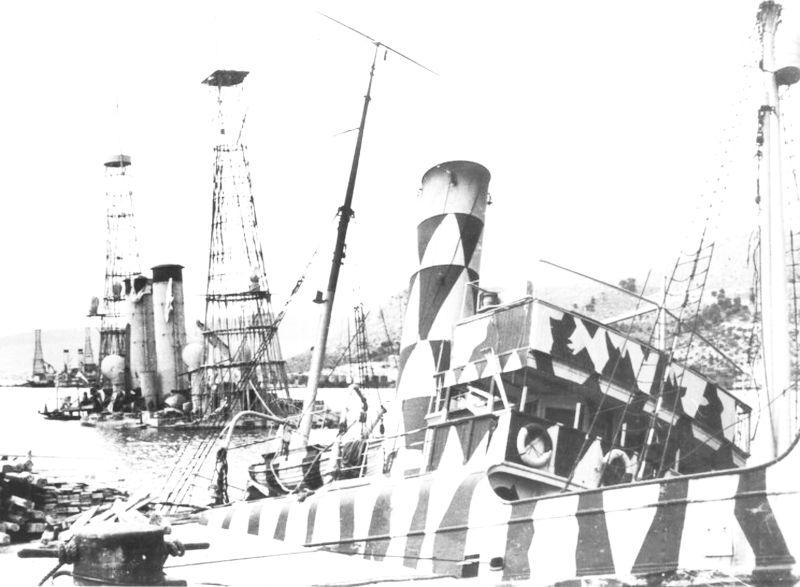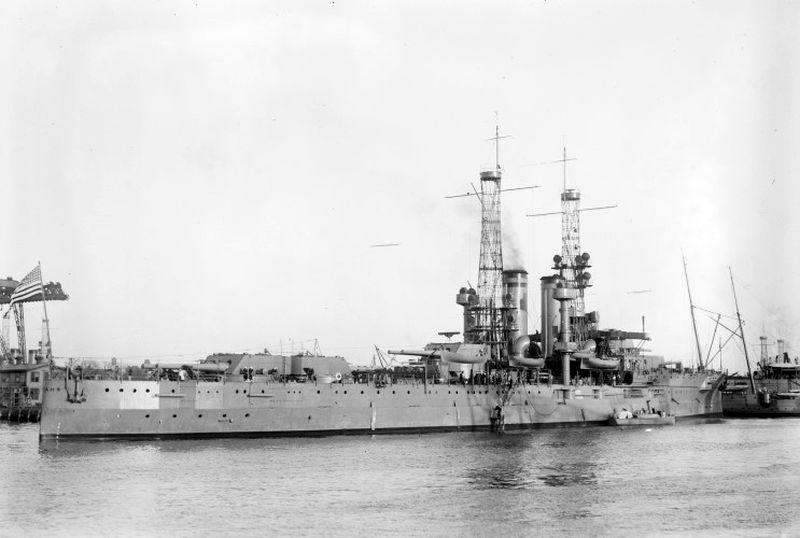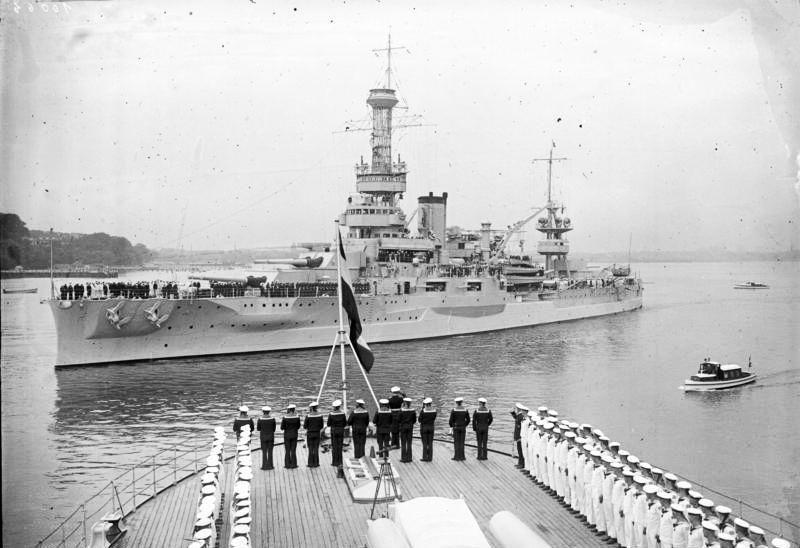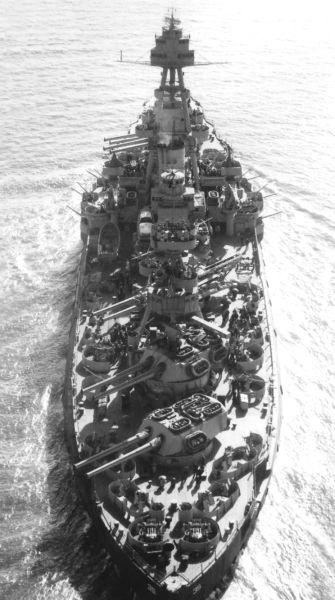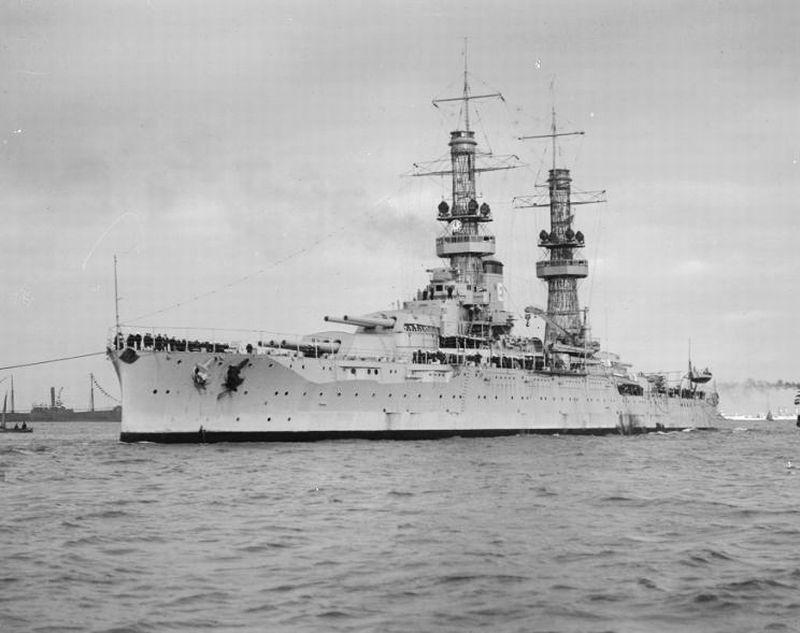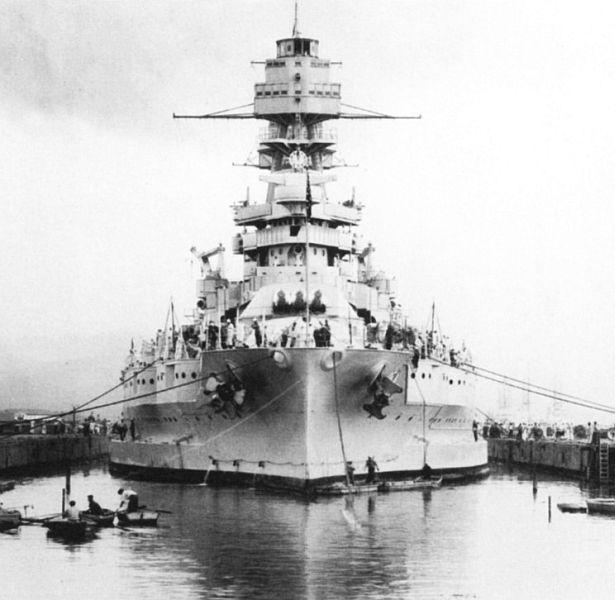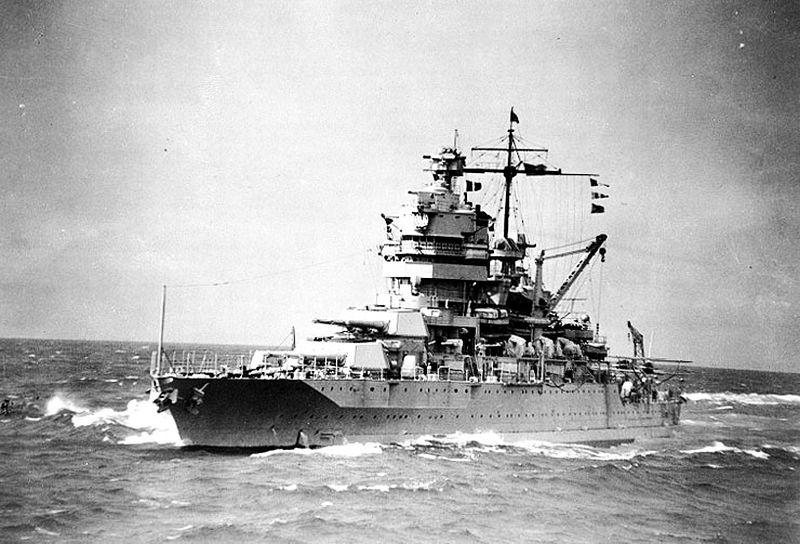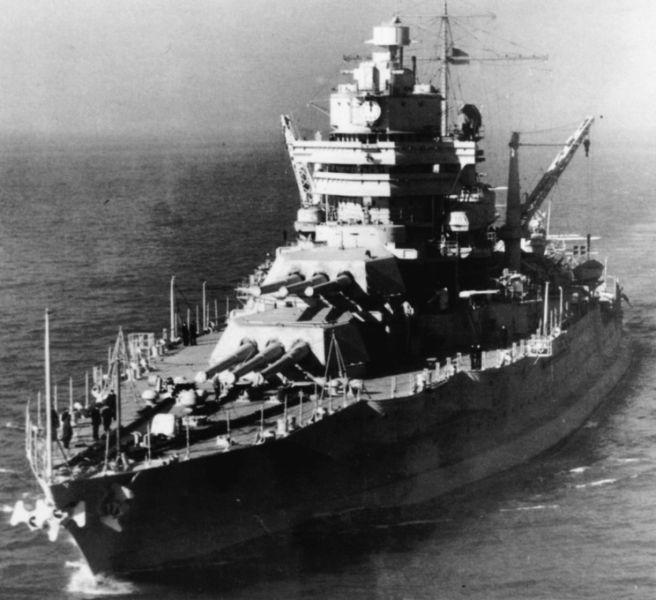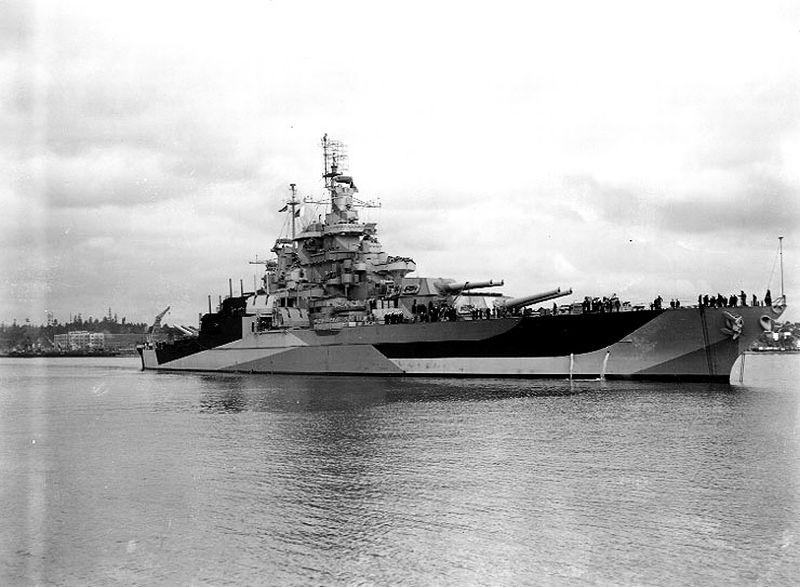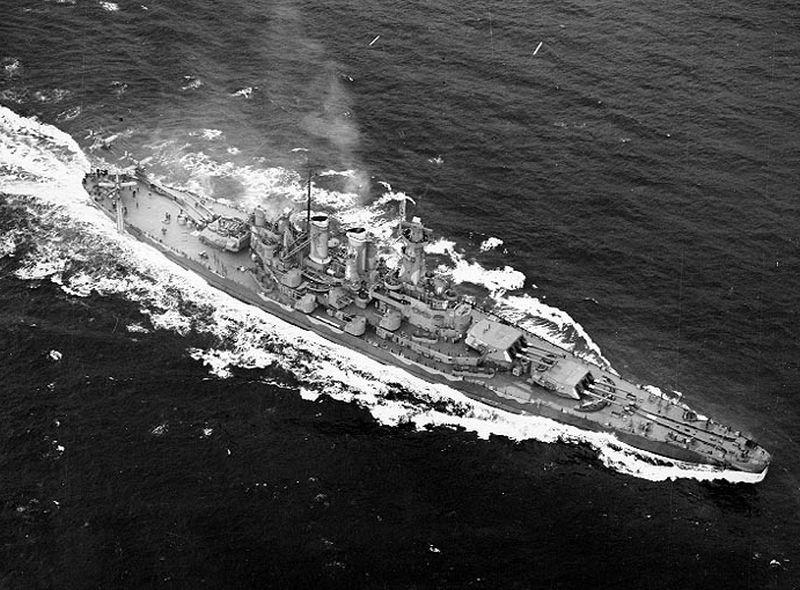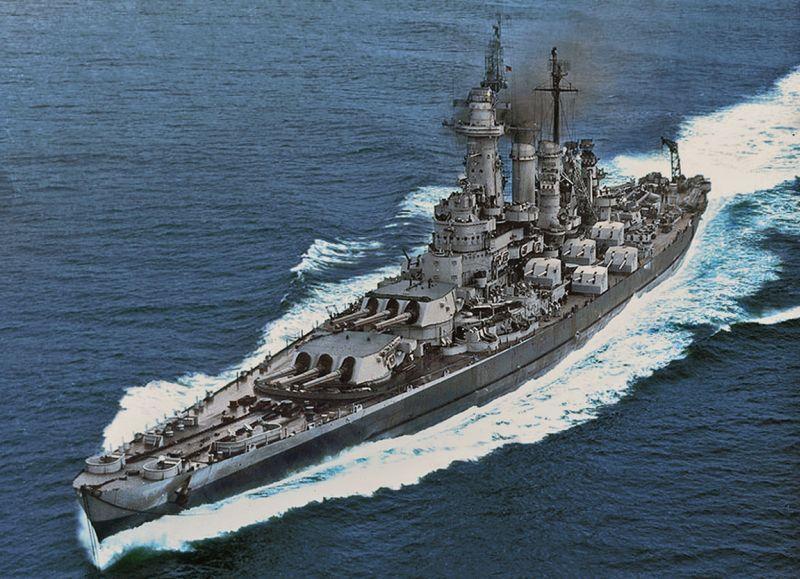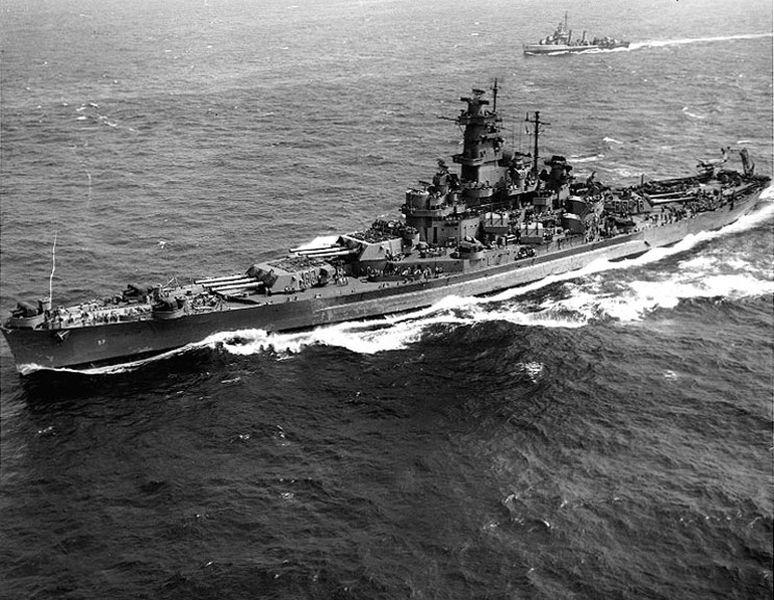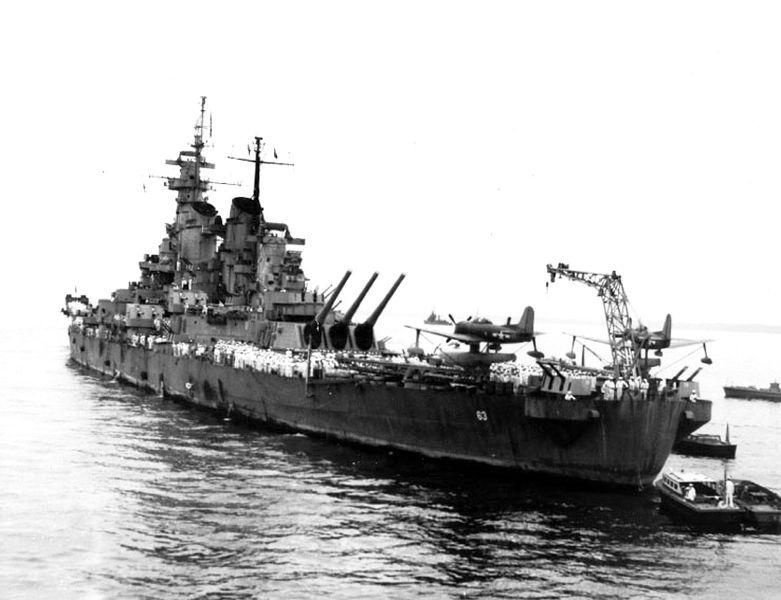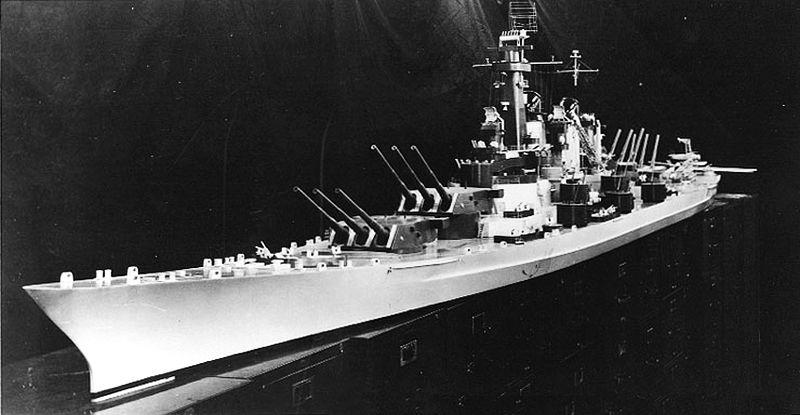Introduction
When the global naval arms race started in the early 1900s, the US Navy soon followed. This article describes how American battleships at first followed the design characteristics of the British HMS Dreadnought. It further expands on how battleship innovation during the 1920s and early 1930s was constrained by international naval treaties and therefore required some ingenuity from the naval engineers. With the advent of WW2 and the treaties having become redundant in the late 1930s, this ingenuity paved the way for a number of successive battleship classes that became a league of their own. However, the article also concludes that in the course of WW2, the primary role of the battleship was soon replaced by the aircraft carrier.
Definitielijst
- battleship
- Heavily armoured warship with very heavy artillery.
History
The era of the American modern battleship began when the Texas was commissioned into the US Navy on August 15, 1895. This 6,682 tons ship was intended for coastal defence and comparable to the Dutch armoured cruisers of the Kortenaer class. This was the first American warship that met the general standards of the modern battleship: a primary armament of guns with a calibre of at least 25cm in revolving gun turrets, propulsion by steam engines and screws and a maximum speed exceeding 15 knots. Five more coastal defence battleships would be built for the US Navy.
On February 20, 1900, USS Kearsarge (BB-6) was commissioned into the US Navy. This was the first blue water battleship: designed and built to cross oceans. The subsequent classes became increasingly larger, better armoured and equipped with more secondary guns. This development continued through the two Mississippi-class battleships, USS Mississippi (BB-23) and USS Idaho (BB-24), which entered service in 1908.
On December 2, 1906, the Royal Navy commissioned the HMS Dreadnought. This was the first battleship in the world with ten 30.5cm guns instead of the usual four. The 18,410 tons battleship was also excellently armoured and could sail at 21 knots. The Dreadnought surpassed all existing battleships in the world and its revolutionary design became the battleship standard for all navies. This standard was implemented to such an extent that henceforth all battleships that met the specifications of the HMS Dreadnought design were simply called dreadnoughts; a new internationally used term was born. All outdated designs were referred to as pre-dreadnoughts and battleships that became larger and more heavily armed than HMS Dreadnought itself were referred to as super-dreadnoughts. All American battleships at that time, from USS Kearsarge to USS Idaho, became pre-dreadnoughts.
The subsequent classes of American battleships were the South Carolina, Delaware, Florida, Wyoming, and New York class dreadnoughts. The latter two classes had a displacement of over 27,000 tons and a main armament of twelve 30.5cm and ten 35.5cm guns respectively and could justifiably be called super-dreadnoughts.
During World War I, the United States Navy began developing and building the so-called Standard-type battleships. These were battleships sharing similar characteristics such as a large firing range, good quality damage control and a limited maximum speed which in turn allowed for a tactical turn radius of less than 700 meters. The latter two characteristics allowed the battleships to form a homogeneous battle line with a relatively large range. The Standard-type battleship concept was applied to the Nevada class, Pennsylvania class, New Mexico class, Tennessee class and Colorado class.
On February 6, 1922, the Washington Fleet Treaty was signed by the naval powers Japan, Italy, France, the United States and Great Britain. The treaty aimed to stop the maritime arms race that was going on at the time. One of the agreements was that no new battleships could be built in the next ten years and that existing battleships could only be replaced if they were older than twenty years. As a result, the US Navy's plan for a South Dakota class of total six ships were cancelled, and the super-dreadnoughts and Standard-type battleships were modernised.
It was not until 1936 that new battleships were designed for the US Navy. Of this new generation of battleships, USS North Carolina and USS Washington were the first to be commissioned in 1941. This generation was called the Fast Battleships because, through the application of new techniques, the US Navy was able to construct a battleship that, despite the size limitations of the Washington and London Fleet Treaties, had a maximum speed of 27 knots. After the North Carolina class came the four ships of the new South Dakota class and then the four Iowa class battleships, which had a maximum speed of even 33 knots. The five battleships of the Montana class were subsequently planned, but during the Second World War it became apparent that the battleship concept was outdated. The aircraft carriers had become the most important ships in a war fleet and therefore the tender for the Montana class was cancelled.
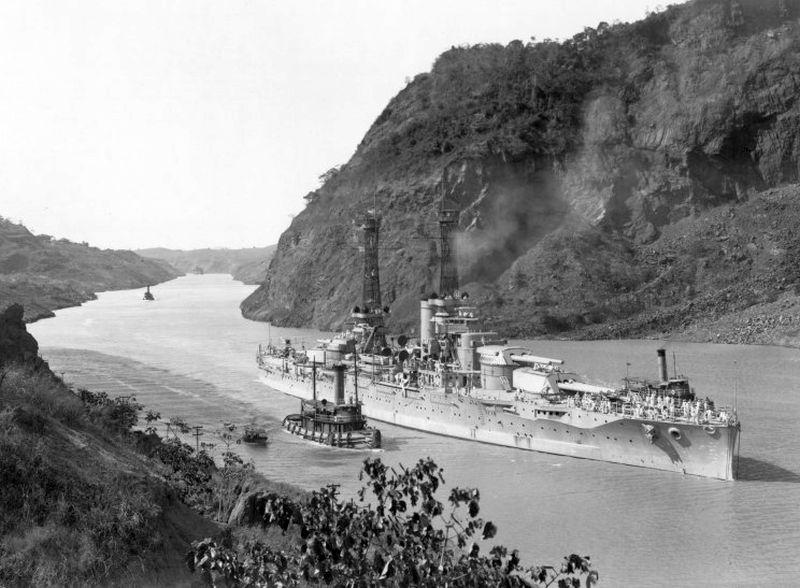
Standard-type battleship USS Nevada (BB-36) transiting the Panama Canal. Source: Courtesy of the Panama Canal Authority
Definitielijst
- battleship
- Heavily armoured warship with very heavy artillery.
American coastal defence battleships
Just like the Dutch protected cruisers and coastal defence ships, the American battleships for coastal defence evolved from the wooden battleships with (auxiliary) sails. At the close of the nineteenth century, a battleship could be defined as an iron or steel warship with protective armour cladding, guns of minimum 25cm and a displacement exceeding 6,000 tons. The first American battleships, the Texas and the Maine, were still developed individually and by a British naval construction company. However, with the introduction of the Indiana class, the concept of a ship class appeared on the American scene for the first time. Such a class concept had the economic advantage that design and development costs could be spread over multiple ships, making them cheaper on balance. In 1897, USS Iowa (BB-4) was the last individually designed battleship that was commissioned into the US Navy.
USS Maine
| Commissioned: | September 17, 1895 |
| Standard displacement: | 6,682 tons |
| Maximum speed: | 17 knots |
| Primary armament: | 4 x 25cm guns |
| Fate: | Sunk by explosion on February 15, 1898 |
USS Texas
| Commissioned: | August 15, 1895 |
| Standard displacement: | 6,682 tons |
| Maximum speed: | 18 knots |
| Primary armament: | 2 x 30.5cm guns |
| Fate: | Sunk as gunnery target in Tangier Sound, Chesapeake Bay |
Indiana-class
| Ships in class: | USS Indiana (BB-1), USS Massachusetts (BB-2), USS Oregon (BB-3) |
| Commissioned: | November 20, 1895 (BB-1), June 10, 1896 (BB-2), July 15, 1896 (BB-3) |
| Standard displacement: | 10,288 tons |
| Maximum speed: | 15 knots |
| Primary armament: | 4 x 33cm guns |
| Fate: | Indiana and Massachusetts sunk as gunnery targets; Oregon scrapped in 1956 |
USS Iowa (BB-4)
| Commissioned: | June 16, 1897 |
| Standard displacement: | 11,346 tons |
| Maximum speed: | 17 knots |
| Primary armament: | 4 x 30.5cm guns |
| Fate: | Sunk as gunnery target |
Definitielijst
- battleship
- Heavily armoured warship with very heavy artillery.
American pre-dreadnoughts
The voyage of the Great White Fleet, a group of 16 American pre-dreadnoughts that circumnavigated the globe in 1907-1909, had been ordered by President Theodore Roosevelt and marked the US Navy's step towards maturity. Until then, the American Navy had been trailing in the shadow of the Royal Navy. The voyage was a great success from an American point of view. However, the reality of the tour also revealed the American battleships to be outdated, especially apparent with the launching of the Royal Navy’s HMS Dreadnought. But it also showed that the US Navy was strategically not well positioned. During the voyage, the fleet had been dependent on British coal, which was delivered to the Americans by British tenders from British ports or ports controlled by Great Britain. After the trip it was clear that the Americans had to set up their own global logistics network and that the fleet had to be modernised.
The last class of pre-dreadnoughts, the Mississippi-class ships USS Mississippi and USS Idaho, were sold by the US Navy to Greece in 1914. The Greek Navy commissioned the battleships as Kilkis and Limnos. In April 1941, both were sunk by German bombers.
Kearsarge-class
| Ships in class: | USS Kearsarge (BB-5), USS Kentucky (BB-6) |
| Commissioned: | February 20, 1900 (BB-5), May 15, 1900 (BB-6) |
| Standard displacement: | 11,540 tons |
| Maximum speed: | 15 knots |
| Primary armament: | 4 x 33cm guns |
| Lot: | Kearsarge converted into a crane vessel in August 1920 and scrapped in 1955; Kentucky scrapped in 1924 |
Illinois-class
| Ships in class: | USS Illinois (BB-7), USS Alabama (BB-8), USS Wisconsin (BB-9) |
| Commissioned: | September 16, 1901 (BB-7), October 16, 1900 (BB-8), February 4, 1901 (BB-9) |
| Standard displacement: | 11,565 tons |
| Maximum speed: | 17 knots |
| Primary armament: | 4 x 33cm guns |
| Lot: | Illinois converted into a floating barracks and scrapped in 1956 ; Alabama sunk as gunnery target in 1921; Wisconsin scrapped in 1922 |
Maine-class
| Ships in class: | USS Maine (BB-10), USS Missouri (BB-11), USS Ohio (BB-12) |
| Commissioned: | December 29 , 1902 (BB-10), December 1, 1903 (BB-11), October 4, 1904 (BB-12) |
| Standard displacement: | 12,500 tons |
| Maximum speed: | 18 knots |
| Primary armament: | 4 x 30.5cm guns |
| Lot: | Scrapped in 1922 |
Virginia-class
| Ships in class: | USS Virginia (BB-13), USS Nebraska (BB-14), USS Georgia (BB-15), USS New Jersey (BB-16), USS Rhode Island (BB-17) |
| Commissioned: | May 7, 1906 (BB-13), July 1, 1907 (BB-14), September 24 , 1906 (BB-15), May 11, 1906 (BB-16), February 19, 1906 (BB-17) |
| Standard displacement: | 15,000 tons |
| Maximum speed: | 19 knots |
| Primary armament: | 4 x 30.5cm guns |
| Lot: | Virginia and New Jersey sunk as gunnery targets; all remaining ships scrapped in 1923 |
Connecticut-class
| Ships in class: | USS Connecticut (BB-18), USS Louisiana (BB-19), USS Vermont (BB-20), USS Kansas (BB-21), USS Minnesota (BB-22), USS New Hampshire (BB-25) |
| Commissioned: | September 29, 1906 (BB-18), June 2, 1906 (BB-19), March 4, 1907 (BB-20), April 18, 1907 (BB-21), March 9, 1907 (BB-22), March 19, 1908 (BB-25) |
| Standard displacement: | 15,000 tons |
| Maximale snelheid: | 19 knopen |
| Primary armament: | 4 x 30.5cm guns |
| Fate: | Scrapped during 1923-1924 |
Mississippi-class
| Ships in class: | USS Mississippi (BB-23), USS Idaho (BB-24) |
| Commissioned: | February 1, 1908 (BB-23), April 1, 1908 (BB-24) |
| Standard displacement: | 15,000 tons |
| Maximum speed: | 19 knots |
| Primary armament: | 4 x 30.5cm guns |
| Fate: | Both sold to Greece in 1914 and sunk by German bombers in April 1941 |
American dreadnoughts and super dreadnoughts
In the run up to World War One, the American Navy followed the Royal Navy in the construction of a new type of battleship and thereby responded to developments with the Japanese Navy. By launching the South Carolina class, the US Navy matched HMS Dreadnought. The subsequent further development of the Delaware and the Florida classes ultimately led to the creation of super-dreadnoughts through the designs of the Wyoming and the New York classes. The latter class of super-dreadnoughts (New York class) would even during the Second World War play a role that cannot be underestimated.
South Carolina-class
| Ships in class: | USS South Carolina (BB-26), USS Michigan (BB-27) |
| Commissioned: | March 1, 1910 (BB-26), January 4, 1910 (BB-27) |
| Standard displacement: | 16,000 tons |
| Maximum speed: | 17 knots |
| Primary armament: | 8 x 30.5cm guns |
| Fate: | Scrapped in 1924 |
Delaware-class
| Ships in class: | USS Delaware (BB-28), USS North Dakota (BB-29) |
| Commissioned: | April 4, 1910 (BB-28), April 11, 1910 (BB-29) |
| Standard displacement: | 20,380 tons |
| Maximum speed: | 21 knots |
| Primary armament: | 10 x 30.5cm guns |
| Fate: | Delaware scrapped in 1924; North Dakota converted into gunnery target in 1924 and scrapped in 1931 |
Florida-class
| Ships in class: | USS Florida (BB-30), USS Utah (BB-31) |
| Commissioned: | September 15, 1911 (BB-30), August 31, 1911 (BB-31) |
| Standard displacement: | 21,800 tons |
| Maximum speed: | 21 knots |
| Primary armament: | 10 x 30.5cm guns |
| Fate: | Florida scrapped in 1932; Utah converted into gunnery target in 1931 and sunk during the Japanese attack on Pearl Harbor in 1941 |
Wyoming-class
| Ships in class: | USS Wyoming (BB-32), USS Arkansas (BB-33) |
| Commissioned: | September 25, 1912 (BB-32), September 17, 1912 (BB-33) |
| Standard displacement: | 27,200 tons |
| Maximum speed: | 21 knots |
| Primary armament: | 12 x 30.5cm guns |
| Fate: | Wyoming converted into a trainingschip in 1931 and scrapped in 1947; Arkansas sunk during the nuclear tests of Operation Crossroads in 1946 |
New York-class
| Ships in class: | USS New York (BB-34), USS Texas (BB-35) |
| Commissioned: | April 15, 1914 (BB-34), March 12, 1914 (BB-35) |
| Standard displacement: | 27,200 tons |
| Maximum speed: | 21 knots |
| Primary armament: | 12 x 30.5cm guns |
| Fate: | New York sunk as gunnery target in 1948; Texas made a museum ship in Houston in 1948 |
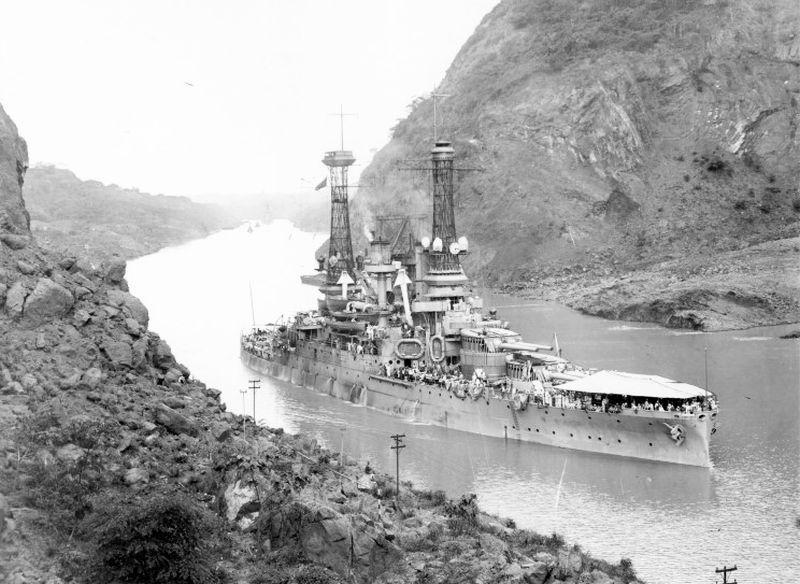
USS Michigan (BB-27) transiting the Panama Canal on June 13, 1920. Source: Courtesy of the Panama Canal Authority
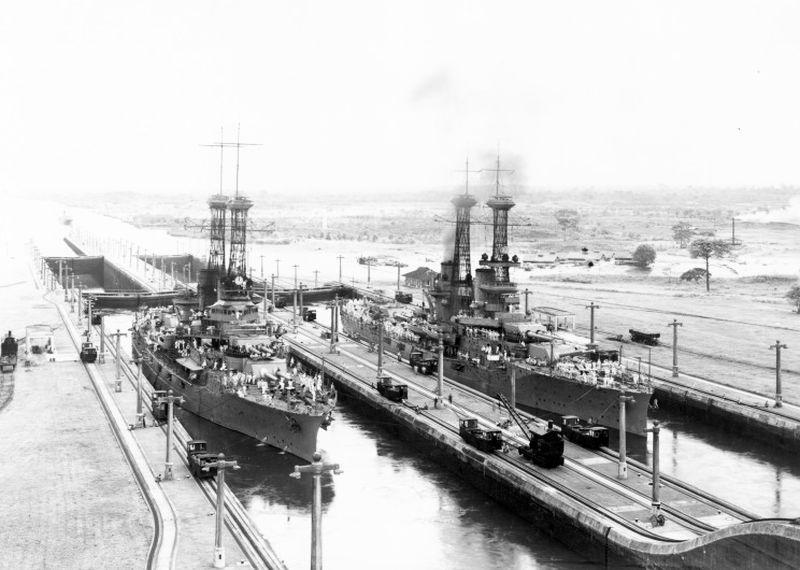
USS Delaware (BB-28) and USS North Dakota (BB-29) in the locks of the Panama Canal on June 14, 1922. Source: Courtesy of the Panama Canal Authority
Definitielijst
- battleship
- Heavily armoured warship with very heavy artillery.
American Standard-type battleships
During World War I, the US Navy started building a series of battleships which would become collectively known as the Standard-type battleships. These were battleships that had had standard characteristics of a long firing range, excellent damage control capabilities, a compact turning circle of less than 700 meters and a limited maximum speed. This allowed the battleships to form a homogenous battle line with a relatively large range. The Standard-type classes of battleships were divided by the US Navy into Battleship Divisions, which consisted of three or four battleships from the same or successive classes. This meant that the battleships within one division were not limited by any shortcomings of the other. Furthermore, it allowed the divisions to be deployed in a better tactical manner and it simplified the logistical, administrative and training requirements.
As a result of the Washington Treaty, the Standard-type battleships underwent important modernisations in the late 1920s and early 1930s and were thus given a second career. The lifespan of the Standard-type battleships lasted until the end of World War II. During the Japanese attack on Pearl Harbor, USS Arizona and USS Oklahoma were lost, but the remaining damaged battleships were repaired and used against the Japanese later in the war. This testified to the quality of the Standard-type battleships. The last two classes of Standard-type battleships, the Tennessee class and the Colorado class, were also called the Big Five.
The last class of Standard-type battleships, the South Dakota class, was cancelled because of the Washington Treaty. The six battleships were already under construction, and most were about 30 percent complete. The hulls were demolished in the course of 1923. The scheduled 72 41cm guns were deployed by the US Army as coastal defence artillery while most of the steel plates remained on the various construction sites until they were used for the construction of new battleships and aircraft carriers during the Second World War.
Nevada-class
| Ships in class: | USS Nevada (BB-36), USS Oklahoma (BB-37) |
| Commissioned: | September 20, 1916 (BB-36), May 2, 1916 (BB-37) |
| Standard displacement: | 27,500 tons |
| Maximum speed: | 21 knots |
| Primary armament: | 10 x 35.5cm guns |
| Fate: | Nevada sunk as gunnery target in 1948; Oklahoma sunk during the Japanese attack on Pearl Harbor |
Pennsylvania-class
| Ships in class: | USS Pennsylvania (BB-38), USS Arizona (BB-39) |
| Commissioned: | June 12, 1916 (BB-38), October 17, 1916 (BB-39) |
| Standard displacement: | 31,400 tons |
| Maximum speed: | 21 knots |
| Primary armament: | 12 x 35.5cm guns |
| Fate: | Pennsylvania scuttled in deep water in 1948; Arizona sunk during the attack on Pearl Harbor |
New Mexico-class
| Ships in class: | USS New Mexico (BB-40), USS Mississippi (BB-41), USS Idaho (BB-42) |
| Commissioned: | May 20, 1918 (BB-40), December 18, 1917 (BB-41), March 24, 1919 (BB-42) |
| Standard displacement: | 32,000 tons |
| Maximum speed: | 21 knots |
| Primary armament: | 12 x 35.5cm guns |
| Fate: | New Mexico and Idaho scrapped in 1947; Mississippi converted into a gunnery training ship and scrapped in 1957 |
Tennessee-class
| Ships in class: | USS Tennessee (BB-43), USS California (BB-44) |
| Commissioned: | June 30, 1920 (BB-43), August 10, 1921 (BB-44) |
| Standard displacement: | 32,300 tons |
| Maximale snelheid: | 21 knopen |
| Primary armament: | 12 x 35.5cm guns |
| Fate: | Sold in 1959 for scrapping |
Colorado-class
| Ships in class: | USS Colorado (BB-45), USS Maryland (BB-46), Washington (BB-47), USS West Virginia (BB-48) |
| Commissioned: | August 30, 1923 (BB-45), July 21, 1921 (BB-46), n.a. (BB-47), December 1, 1923 (BB-48) |
| Standard displacement: | 32,600 tons |
| Maximum speed: | 21 knots |
| Primary armament: | 8 x 41cm guns |
| Fate: | Colorado, Maryland and West Virginia sold for scrapping in 1959; Washington’s construction terminated and sunk as gunnery target in 1924 |
South Dakota-class
| Ships in class: | South Dakota (BB-49), Indiana (BB-50), Montana (BB-51), North Carolina (BB-52), Iowa (BB-53), Massachusetts (BB-54) |
| Commissioned: | n.a. |
| Standard displacement: | 43,200 tons |
| Maximum speed: | 23 knots |
| Primaire bewapening: | 12 x 41cm kanonnen |
| Fate: | Entire class cancelled prior to completion as a direct result of the Washington Navy Treaty limitations |
Definitielijst
- Battleship
- Heavily armoured warship with very heavy artillery.
American Fast Battleships
Only from 1937 onwards, new battleship designs were presented by the General Board of the US Navy because of the rearmament of the major maritime powers. The designs of the new North Carolina class and South Dakota class were still determined by the Washington and London Fleet Treaties. As a result, the standard displacement of these battleships was limited to 35,000 tons and the maximum speed could only reach 27 knots, despite technical developments. The six battleships of the Iowa class and the five battleships of the Montana class were no longer limited by the fleet treaties, and this allowed the US Navy designers to develop battleships of 45,000 tons and even 65,000 tons, respectively, with a maximum speed of 33 and 28 knots. However, only the first four Iowa-class ships of these super battleships would be completed. The remaining two Iowa class ships and the entire Montana class were cancelled as they were no longer required.
Furthermore, by the end of World War II it had become clear that the battleship concept was outdated. Battleships, American, British and Japanese, had proven very vulnerable to air attack during the war, despite the extensive anti-aircraft batteries they had in 1944 and 1945. The primary role in naval warfare had been taken over by aircraft carriers.
North Carolina-class
| Ships in class: | USS North Carolina (BB-55), USS Washington (BB-56) |
| Commissioned: | April 9, 1941 (BB-55), May 15, 1941 (BB-56) |
| Standard displacement: | 35,102 tons |
| Maximum speed: | 27 knots |
| Primary armament: | 9 x 41cm guns |
| Fate: | North Carolina museum ship in Wilmington since 1962; Washington sold for scrapping in 1961 |
South Dakota-class
| Ships in class: | USS South Dakota (BB-57), USS Indiana (BB-58), USS Massachusetts (BB-59), USS Alabama (BB-60) |
| Commissioned: | March 20, 1942 (BB-57), April 30, 1942 (BB-58), May 12, 1942 (BB-59), August 16, 1942 (BB-60) |
| Standard displacement: | 35,000 tons |
| Maximum speed: | 27 knots |
| Primary armament: | 9 x 41cm guns |
| Fate: | South Dakota and Indiana sold for scrapping in 1962 and 1963; Massachusetts en Alabama were each made a museum ship at Fall River and Mobile |
Iowa-class
| Ships in class: | USS Iowa (BB-61), USS New Jersey (BB-62), USS Missouri (BB-63), USS Wisconsin (BB-64), Illinois (BB-65), Kentucky (BB-66) |
| Commissioned: | February 22 , 1943 (BB-61), May 23, 1943 (BB-62), June 11, 1944 (BB-63), April 16, 1944 (BB-64), n.a. (BB-65), n.a. (BB-66) |
| Standard displacement: | 45,000 tons |
| Maximum speed: | 33 knots |
| Primary armament: | 9 x 41cm guns |
| Fate: | Iowa, New Jersey, Missouri and Wisconsin were each made a museum ship at San Pedro, Camden, Honolulu, and Norfolk respectively; Illinois and Kentucky cancelled prior to completion and scrapped |
Montana-class
| Ships in class: | Montana (BB-67), Ohio (BB-68), Maine (BB-69), New Hampshire (BB-70), Louisiana (BB-71) |
| Commissioned: | n.a. |
| Standard displacement: | 65,000 tons |
| Maximum speed: | 28 knots |
| Primary armament: | 12 x 41cm guns |
| Fate: | Entire class cancelled |
Definitielijst
- battleship
- Heavily armoured warship with very heavy artillery.
Information
- Article by:
- Peter Kimenai
- Translated by:
- Simon van der Meulen
- Published on:
- 12-01-2025
- Feedback?
- Send it!
Sources
- DULIN, R.O. JR. & GARZKE, W.H.JR., Battleships, Naval Institute Press, Annapolis, Maryland, 1976.
- HORE, P, Slagschepen, Veltman Uitgevers, Utrecht, 2006.
- LYON, H, Encyclopedie van de belangrijkste oorlogsschepen ter wereld, Scriptoria, Antwerpen, 1980.
- MCCURTIE, F.E., Jane`s Fighting Ships of World War II, Military Press, New York, 1989.
- TERZIBASCHITSCH S., Battleships of the US Navy in World War II, Bonanza Books, New York, 1977.
